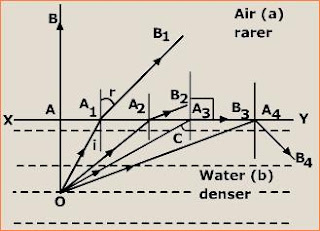Light
Light is a most common aspect of our life. It's
everywhere and surrounds us wherever we go. The light which may seem very
simple and easy to us carries magnificent properties and extraordinary
importance. Life is not possible without light and it is a source of knowledge
for us. It contains phases of universe in it and it is scattered everywhere in
the universe. It is present since the emergence of universe and it will last
till the end of the universe. Sir Albert Einstein, a versatile genius got
inspired to formulate various theories by light.
So let's discover more about the light......
Introduction
Light is an electromagnetic wave which contains
electric and magnetic components moving perpendicular to each other. This fact
was first stated by sir Michael Faraday but he was unable to prove it
mathematically rather it was proved by his young friend sir James Clark
Maxwell. Light is obtained from various sources but the primary source of light
is Sun and light takes 8 minutes and
16.6 seconds to travel from sun to earth . It will ensure constant supply of
light for billions of years. There are many other sources of light.
Light possess the fastest known speed i.e. 3*108
m/s in the universe. Light is an electromagnetic wave thus it doesn’t
require any medium for it’s propagation in space. We are able to see any object
only when the light coming from an object(can be it’s own or reflected) is received by our eyes.
Structure
Visible portion of electromagnetic spectrum which
covers colours violet, indigo, blue, green,
yellow, orange and red can easily be obtained by passing a beam of white
light through a glass prism and is commonly observable in the form of rainbow.
Properties
Light shows many properties
which leads to the emergence of various natural phenomena of light. These
various properties of light are used in various instruments and are extremely
helpful in describing a large arena of natural processes.
Some of it’s properties are
listed below.....
>>Reflection
>>Reflection
It is the process of bouncing back of light when it
hits the surface of a body. This is due to the reflection of light that we can
see non-luminous objects. The simplest example of this is mirror which reflects
light coming from a body and forms a image of that body. A polished surface is
a better reflector of light than a rough surface.
>>Refraction
The process of bending of light when it passes from
one medium to another. It depends upon the density of two mediums. The speed of
light changes resulting in the refraction of light. This is a very important
property for optics as it directed the development of lenses and refracting
telescopes. A pencil dipped in a glass of water when observed from outside
appears to be broken due to this property.
>> Total Internal reflection
>>Dispersion
The process of splitting up of white light into
it’s component colours when it passes through a transparent medium is called
dispersion of light. When a white light passes through a glass prism a band of
seven colours is obtained which consists of seven colours i.e. VIBGYOR.
Rainbow is formed by the dispersion of sunlight by
rain drops present in the atmosphere.
>> Interference
The distribution of energy due to the disturbance
of one wave by another wave when two light waves from different sources meet
together is called interference of light. This modifies the distribution of
energy in waves. There are two types of interference:-
a)Constructive interference
b)Destructive interference
Surface water waves show destructive interference
and it can also be observed in radio waves. Rogue waves(ocean waves) show
constructive interference.
>> Polarization
It is the property of a wave that it can oscillate
with more than one orientation. Light exhibits polarization. It is very useful
in the study of branches of science like optics, seismology, radio waves and micro
waves.
Nature of light
As stated by the wave theory and particle theory of
light it has a dual nature. It behaves as a wave as well as a particle. At
first light was treated only as a particle which successfully explained
phenomena like reflection and refraction of light but it failed to explain the
phenomena like interference and diffraction. Then wave theory of light came
into effect(proposed by Huygens) which successfully explained interference and
diffraction.
When we talk about the particle theory of light,
the photon or quantum is taken as the particle of light.
Planck’s quantum theory of radiation
It was proposed in 1901 by sir Max Planck which
forwarded that radiant energy (including light) is not emitted or absorbed
continuously but discontinuously in the form of small packets of energy called quanta or photon.
Energy carried by a quantum of radiation was given by formula:-
E = hv Where h is planck’s constant(h = 6.626 * 10-34
j s) whereas v is frequency of light.
Speed of light
Suppose our sun is switched
off or it is taken off from its place then what we are going to observe for
next 8 minutes, the answer is that we
will be totally unaware of this for next 8 minutes because light takes nearly 8
minutes to reach Earth from the Sun and in this period we will be continuously receiving
light of sun that was emitted by it before its departure. Similarly when we stare
at the sky then we are watching some of the stars those were dead long time back.
Various phenomena of light
Rainbows
Afterglow
Airglow
Alpenglow
Belt of Venus
Auroral light
Green flash
Light pillar
Mirages
Tyndall effect
Sun dogs etc.
Bioluminescence
It is the production and
emission of light by a living organism. It is found in microorganisms,
vertebrates, invertebrates and other living organisms. They contain a enzyme
called luciferase and a pigment luciferin. Some of the bioluminescent organisms
are-
a)Fireflies
b)Glow worms
c)Millipedes(motyxia)
d)Annelids
e)Mollusc
f)Anglerfish
g)Catshark
i)Flashlight fish
j)Lanterfish
k)Protists
l)Fungi(Panellus stipticus,
Omphalotus olearius, Collybia tuberosa)




















